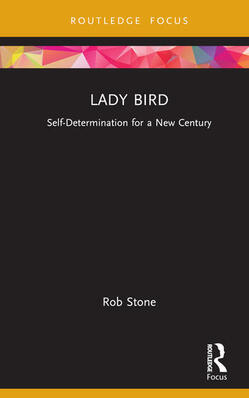
LADY BIRD: SELF-DETERMINATION FOR A NEW CENTURY is with Routledge in the Cinema and Youth Cultures series edited by Yannis Tzioumakis and Siân Lincoln. Universally lauded for its script and performances, as well as the consecration of debut writer-director Greta Gerwig as a major talent in American independent cinema, LADY BIRD (Gerwig, 2017) is much more than a semi-autobiographical growing-up story of a young woman in Sacramento. It is also a portrait of an American youth subculture struggling to assert its identity between the shock of 9/11 in 2001 and the global financial crisis of 2008. This new book examines matters of class, education, religion and the economy in the film in relation to female subjectivity and the context of LADY BIRD being set in 2002 and made in 2017. It aligns the dialogue and actions of Lady Bird with feminist ideas and libertarian philosophies, and reveals the tensions that guide and complicate attempts at self-determination for a new century. Exploring the film’s aesthetic innovations, its production and distribution history, which includes the rise of the A24 company and the context of women’s independent filmmaking in the 2010s and 2020s, this book holds Lady Bird to be testament to a subsection of American youth culture that tasked itself with self-determination for a new century. Easily my best and favourite book!
ROUTLEDGE
AMAZON
ROUTLEDGE
AMAZON
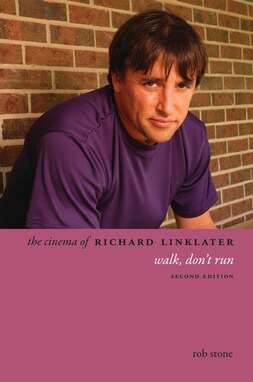
The second edition of THE CINEMA OF RICHARD LINKLATER: WALK, DON'T RUN was published by Columbia University Press in 2018. It involved a major revision and rewrite, taking into consideration the films directed by Linklater since the first edition in 2013. The second edition covered BEFORE MIDNIGHT and therefore required a restructuring that brought the Before trilogy together in one new chapter entitled 'WALKING AND TALKING'. It also included a completely new chapter on BOYHOOD entitled 'WINGING IT' and several new sections that considered BERNIE, EVERYBODY WANTS SOME!!, LAST FLAG FLYING and Linklater's Hulu web series UP TO SPEED. For the cover, I managed to track down Matt Lankes, the set photographer on BOYHOOD whose photos are collected in the book BOYHOOD: TWELVE YEARS ON FILM, and he generously offered his portfolio of shots of Linklater stretching back through BOYHOOD and the production of FAST FOOD NATION and BAD NEWS BEARS from which the colour cover shot of Linklater in a baseball dug-out was selected. The writing entailed a return trip to Austin to do a catch-up interview with Linklater at the Austin Film Studios and I celebrated its publication with a holiday in Messinia, staying in the Costa Navarino Hotel, where I met Julie Delpy (yeah, surreal!) and tracked down many of the locations of BEFORE MIDNIGHT.
COLUMBIA UNIVERSITY PRESS
AMAZON
COLUMBIA UNIVERSITY PRESS
AMAZON
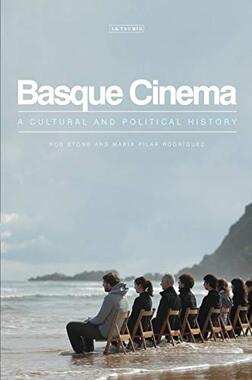
Co written with María Pilar Rodríguez of the University of Deusto in San Sebastian, BASQUE CINEMA: A CULTURAL AND POLITICAL HISTORY was made possible by a Leverhulme major research fellowship that allowed me to spend two years 2012-14 living in Spain and researching and writing in the Basque Country. Cinema has always been a vital medium for articulating the Basque region's unique identity and politics and this, the first definitive study of Basque cinema in English, provides a systematic analysis of the key Basque films, directors and cinematic institutions. Its narrative moves from the romanticised Basque Country travelogues of Pathe to the coded oppositional aesthetics of Franco-era films; from the post-Franco 'new wave' supported by regional government funding to the boom in auteurist cinema during the 1980s and 1990s. It also charts the contemporary impact of the film institute Basque Filmoteca and television channel Euskal Telebista in producing and disseminating Basque-language films. Based on archival research, close readings of films and in-depth interviews with influential figures in the Basque film scene, it was a great project that got a great cover, taken from the documentary BERTSOLARI. This was hard work but a labour of love and a great privilege to work so closely with Pilar and to spend so much time in the Basque Filmoteca in San Sebastian.
BLOOMSBURY
AMAZON
BLOOMSBURY
AMAZON
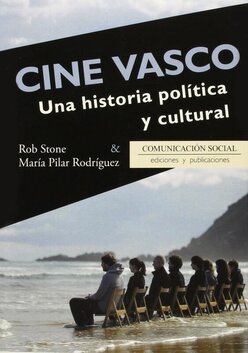
CINE VASCO: UNA HISTORIA POLITICA Y CULTURAL supone el más completo estudio abordado hasta la fecha sobre la cinematografía vasca, deteniéndose en el análisis de sus principales períodos, obras, realizadores e instituciones. A lo largo de sus páginas se exploran los vínculos entre la actividad fílmica y las circunstancias históricas, políticas y culturales de la historia reciente de Euskadi, y se profundiza en el papel desempeñado por instituciones como la Euskadiko Filmategia / Filmoteca Vasca e iniciativas como Kimuak. Desde sus orígenes, el desarrollo del cine vasco se ha visto fuertemente condicionado por imperativos lingüísticos, culturales, propagandísticos e industriales, los cuales son estudiados de manera sistemática. Todo ello, hace de esta obra una lectura imprescindible para especialistas y para quienes se interesan desde cualquier perspectiva por el cine vasco, la historia del cine español y la actualidad el cine europeo. Asimismo, el lector podrá acceder a una nutrida selección de películas y cortometrajes disponibles libremente en internet a través de los códigos QR que encontrará a lo largo de los diez capítulos que integran este volumen.
COMUNICACION SOCIAL
AMAZON
COMUNICACION SOCIAL
AMAZON
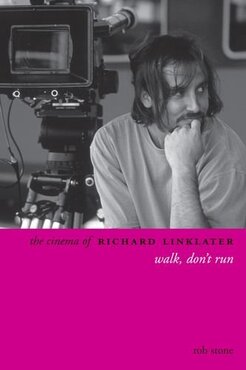
The first edition of THE CINEMA OF RICHARD LINKLATER: WALK, DON'T RUN was published by Wallflower as an imprint of Columbia University Press in 2013. It offers a brisk account of the walking and talking of his no/low-budget American independent films and shows how they converse with the philosophical traditions of the European art house, arguing that Richard Linklater's films are some of the most critical, political, and spiritual achievements of contemporary world cinema. Probably the book of mine that I most wanted to read, which is the best reason for writing one. It actually came out of an invitation from Paul Cooke to contribute a chapter on Almodóvar to the book that he was editing on World Cinema's Dialogues with Hollywood, to which I counter-offered a chapter on the first two Before films. And from there to a book proposal and immersion in the world of Linklater, which included two weeks in Austin in the summer of 2009, when Linklater graciously conceded two days of interviews. Probably the only book of mine that I love and don't mind re-reading - or re-writing as the 2018 second edition showed. The book is deceptively structured, I think, with few readers realising that it starts out as a Debordian drift and ends up a Cubist portrait of Linklater, which are the two main critical frameworks I set to understanding his cinema.
COLUMBIA UNIVERSITY PRESS
AMAZON
COLUMBIA UNIVERSITY PRESS
AMAZON
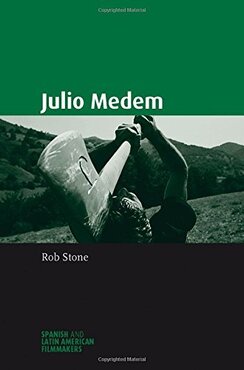
JULIO MEDEM was published by Manchester University Press in 2007. It went through several rewrites and the 120,000 word version for the Spanish market, that was never published, is the great one. This is still a thorough account of the life and films of the Spanish-Basque filmmaker Julio Medem and was the first book in English on the internationally renowned writer-director of VACAS, LA ARDILLA ROJA, TIERRA, LOS AMANTES DEL CIRCULO POLAR AND LUCIA Y EL SEXO as well as PELOTA VASCA and a preview of CAOTICA ANA. Initial chapters explore Medem's childhood, adolescence and education and examine his earliest short films and critical writings against a background of a dramatically changing Spain. Later chapters provide accounts of the genesis, production and release of Medem's challenging and sensual films, which feed into complex but what I hope are lucid analyses of their meanings, both political and personal, in which I draw on traditions and innovations in Basque art, Spanish cinema and European philosophy to create a complete and provocative portrait of Medem and his work. Interviewing Medem as well as Emma Suárez, who was exactly like her character in LA ARDILLA ROJA, Carmelo Gómez, Nancho Novo, Alberto Iglesias and Javier Aguirresarobe was an adventure and privilege - all wonderful and gracious interviewees.
MANCHESTER UNIVERSITY PRESS
AMAZON
MANCHESTER UNIVERSITY PRESS
AMAZON
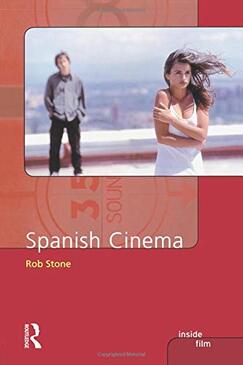
SPANISH CINEMA was published by Longman in 2001 and the imprint is now with Routledge. Almost twenty years later, it's a book for which I have tremendous affection. The invitation came from series editor Alexander Ballinger, who was putting the series together for Longman, and it set me off on an academic career. It's quite idiosyncratic, moving quickly through a wealth of exciting and distinctive film-makers who have consistently provided a condoning or dissenting eye on Spanish history and culture. I sought original interviews with Spanish Cinema luminaries such as Carlos Saura, Julio Medem, Imanol Uribe and Elías Querejeta and most of the book stands up well. It made a lot of friends for me worldwide and branded me a Hispanist. Its strengths remain chapters on Spanish Cinema during the transition, Basque cinema, childhood in Spanish cinema, and the interview with Elías Querejeta that was quite an experience. After being ushered into his office by an assistant whose sole purpose it seemed was to refill his glass of wine, Querejeta eyed me suspiciously for a long time and then picked up the phone and dialled before asking the police if they would come and arrest me, this idiot, for the foolhardy errand of wanting to write a book on Spanish Cinema. Querejeta on fine form. Later, to the amazement of everyone, he turned up to the book launch.
ROUTLEDGE
AMAZON
ROUTLEDGE
AMAZON
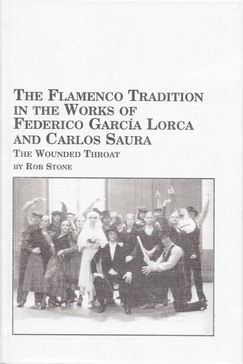
Though published in 2004 I consider FLAMENCO TRADITIION IN THE WORKS OF FEDERICO GARCIA LORCA AND CARLOS SAURA: THE WOUNDED THROAT to be my first monograph because it was my doctoral thesis - and every time I have occasion to refer to this it convinces me it's the best thing I've ever written. It explores the meaning and importance of flamenco in the works of the poet and playwright Federico Garcia Lorca and the film-maker Carlos Saura. Lorca and Saura shared a fascination for flamenco as a medium for the existential ideology of the marginalized and disenfranchised and this work evaluates the development of these themes through a close, contextual study of their works, which are linked explicitly by Saura's film adaptation of Lorca's BODAS DE SANGRE and, more profoundly, by their use of flamenco to express ideas of sexual and political marginalization in pre- and post-Francoist Spain respectively. The study demonstrates that an understanding of the symbolism, visual style, characters, themes and performance system of flamenco is key to a greater understanding of the social, sexual, political and existential themes in the works of Lorca and Saura, and that this in turn allows for analysis of the evolution of flamenco and the development of modern Spain. Currently priced at a ridiculous £363.38 on Amazon!
EDWIN MELLEN
AMAZON
EDWIN MELLEN
AMAZON
